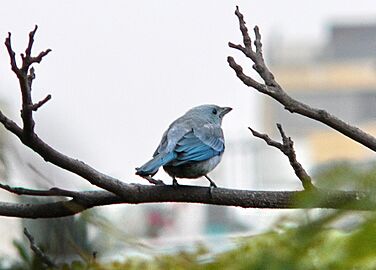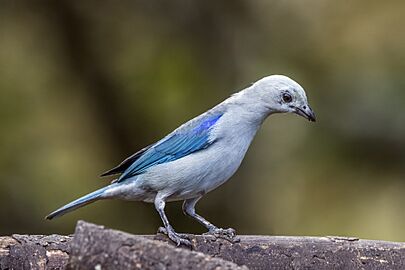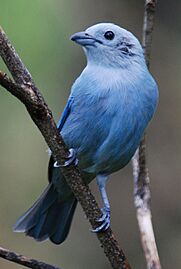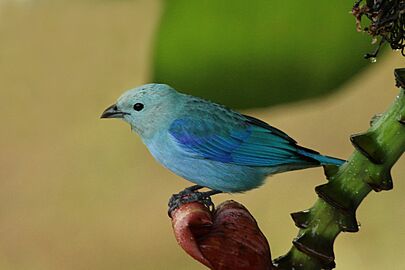Blue-gray tanager facts for kids
Quick facts for kids Blue-gray tanager |
|
|---|---|
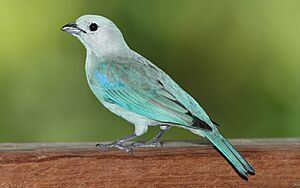 |
|
| T. e. cana in Darién National Park (Panama) |
|
| Conservation status | |
| Scientific classification | |
| Genus: |
Thraupis
|
| Species: |
episcopus
|
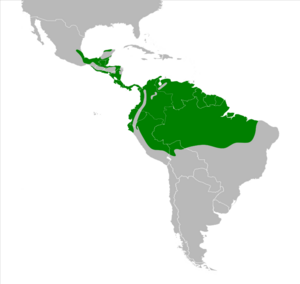 |
|
| Synonyms | |
|
|
The blue-gray tanager (Thraupis episcopus) is a medium-sized South American songbird. It belongs to the tanager family, Thraupidae. You can find this bird from Mexico all the way south to northeast Bolivia and northern Brazil. It lives across most of the Amazon Basin. This bird was also brought to Lima in Peru. In Trinidad and Tobago, people often call this bird the blue jean bird.
Contents
About the Blue-Gray Tanager
How it Got its Name
The blue-gray tanager was first described in 1760 by a French zoologist named Mathurin Jacques Brisson. He saw a bird from Brazil and gave it a Latin name, Episcopus avis. Later, in 1766, a famous Swedish scientist named Carl Linnaeus officially named the bird Tanagra episcopus. The word episcopus is Latin for "bishop." This name likely refers to the bird's bright, colorful feathers, which might remind someone of a bishop's robes. The bird's current group name, Thraupis, was given by Friedrich Boie in 1826.
Different Kinds of Blue-Gray Tanagers
There are 14 different types, or subspecies, of the blue-gray tanager. They all look a bit different, mainly in the color of their blue feathers. For example, the blue on their shoulders might be a different shade than the rest of their body. Some can be grayish, greenish, or purplish-blue. Their shoulder patches can be lavender, dark blue, or even whitish.
For instance, the T. e. berlepschi lives only in Tobago. It has brighter and darker blue colors on its back and shoulders. The T. e. neosophilus has a violet shoulder patch. You can find it in northern Venezuela, Trinidad, eastern Colombia, and northern Brazil. Another type, T. e. mediana, lives in the southern Amazon area and has a white patch on its wing. The T. e. cana from the northern Amazon has blue shoulders.
What the Blue-Gray Tanager Looks Like
This bird is about 16 to 18 centimeters (6 to 7 inches) long. It weighs between 30 and 40 grams (about 1 to 1.4 ounces). Adult blue-gray tanagers have a light bluish head and belly. Their upper parts are a darker blue. They also have a special patch on their shoulder that is a different shade of blue. Their bill is short and quite thick. Both male and female birds look similar. However, young birds are much duller in color.
The blue-gray tanager's song sounds like a squeaky twittering. They also make tseee and tsuup call sounds.
Where They Live and How They Live
Habitat and Food
Blue-gray tanagers like to live in open woodlands, gardens, and farm areas. They mostly eat fruit. But they also enjoy some nectar, insects, and other small creatures like spiders. These birds are very common. They are often restless, noisy, and not afraid of people. You usually see them in pairs, but sometimes in small groups. They do well living near humans. They even eat cultivated fruits like papayas.
Nesting and Babies
Female blue-gray tanagers usually lay two eggs, but sometimes one or three. The eggs are whitish to gray-green with dark marks. They build a deep cup-shaped nest in a high tree fork or a crack in a building. The female bird sits on the eggs for 14 days. The young birds then stay in the nest for another 17 days before they can fly. Sometimes, other birds called cowbirds will lay their eggs in the tanager's nest.
Blue-Gray Tanagers and Farms
Blue-gray tanagers do well in some areas that humans have cleared for animals to graze. They are not as attracted to buildings or places with lots of people or farm animals. They still live in forests. But they will temporarily move into old farm fields that are no longer used. They go there to find wild fruits. They are more common in forests that have grown back after being cut down and burned than in untouched forests.
Status of the Blue-Gray Tanager
The blue-gray tanager is found in many places and is very common. Because of this, it is listed as "Least Concern" on the IUCN Red List of Threatened Species. This means that experts believe it is not currently at risk of disappearing.
Subspecies Gallery



